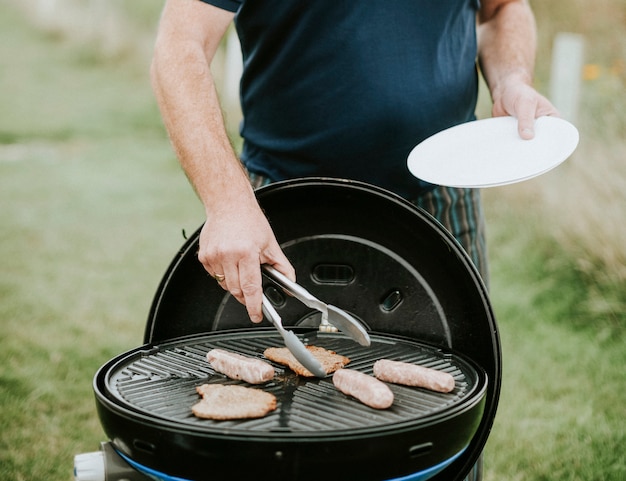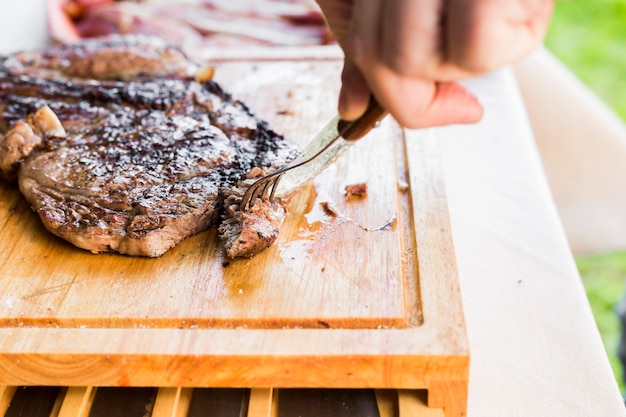Ah, brisket. The king of barbecue, the crown jewel of slow-smoked meats. There's something truly magical about biting into a perfectly cooked brisket – tender, juicy, bursting with smoky flavor. But let's be honest, achieving that kind of perfection takes more than just throwing a piece of meat on the smoker. It's an art form, a dance between heat and time, with a dash of patience and a sprinkle of know-how. Over the years, I've learned a thing or two about smoking brisket, and I'm thrilled to share my insights with you. So, grab a cold drink, settle in, and let's embark on this journey to brisket nirvana.
(Part 1) - Choosing the Right Brisket: The Foundation of Flavor

Think of your brisket like the canvas for a masterpiece – if you start with a subpar cut, you'll never achieve a truly breathtaking final product. So, where do you even begin? First, understand that not all briskets are created equal. You want a cut that's got a good layer of fat – it's essential for juicy, tender results. I always opt for a whole packer brisket, which includes both the point and the flat. It's a bit of a beast, but trust me, the flavor payoff is incredible. You can always trim it down later, but that initial fat is your friend.
The Butcher's Touch: Finding the Perfect Source
Now, where you buy your brisket is just as important as the cut itself. You want a butcher who knows their stuff – someone who can tell you about the origin of the beef, how it was raised, and how it was aged. I've got a little local butcher near me who's a real gem. He gets his beef from a small farm, and the quality is top-notch. But if you're struggling to find a decent butcher, look for a local farmers market. You'll often find excellent quality meat there, and you can chat to the farmers themselves. It's a great way to learn about the journey your brisket took, from field to your smoker.
What to Look For: The Telltale Signs of Quality
Once you've found a good source, take a close look at your brisket. Here's what to keep an eye out for:
- Marbling: The secret to juicy, tender brisket lies in the marbling – those small streaks of fat running through the meat. The more marbling, the better. It's like a natural basting system for your brisket, keeping it moist and flavorful.
- Fat Cap: A good fat cap is crucial for protecting the meat during smoking. Aim for a layer of fat that's at least half an inch thick. It acts like a natural cover, keeping the meat juicy and flavorful. Don't be shy about trimming excess fat, but remember, a good fat cap is your friend.
- Color: A deep red color is a sign of freshness. Avoid any brisket that's pale or has a grayish tinge. That's a sign it might not be as fresh. Trust your instincts – if it doesn't look right, don't buy it.
(Part 2) - Trimming and Seasoning: Setting the Stage for Flavor

You've got your brisket, now it's time to get your hands dirty – literally. Trimming and seasoning are crucial steps in prepping your brisket for the smoker. It's about preparing the canvas for your masterpiece.
The Fat Cap Trim: Finding the Sweet Spot
First, you need to trim that fat cap. You don't want it to be too thick, or it'll just render out and leave you with a dry brisket. Aim for about a quarter of an inch thickness. You can save the trimmed fat to make brisket tallow, which is amazing for frying and cooking. It's a classic reminder that every part of the brisket is valuable, and there's no waste in this process.
Banishing the Silver Skin: A Bit of Tedious Detail
The next step is to remove the silver skin. This is a thin, tough membrane that sits on the surface of the brisket. It won't render down like fat, so it needs to go. It's a bit tedious, but trust me, it's worth it. You'll be rewarded with a more tender and flavorful brisket. Use a sharp knife to carefully peel it off, working slowly and steadily.
Seasoning Your Brisket: The Flavor Palette
Now, you're finally ready to season your brisket. This is where you can get creative, but here's my go-to recipe. I like to use a simple salt and pepper rub, adding a bit of garlic powder and onion powder for extra flavor. But don't be afraid to experiment. You can add other spices like paprika, cumin, or chili powder, depending on your preference. Think of it like a flavor palette – each ingredient adds a unique note to the overall flavor profile.
Whatever rub you choose, make sure to rub it into the brisket, really getting it into those nooks and crannies. Don't be shy, you want the brisket to be well-coated. You can even use your fingers for this, but make sure your hands are clean!
(Part 3) - Getting Your Smoker Ready: The Theater of Smoke

Your brisket is seasoned, now it's time to fire up the smoker. This is where the magic begins, where you're transforming a piece of raw meat into a smoky masterpiece.
Choosing the Right Wood: The Symphony of Smoke
First up, you need to choose the right wood for smoking. There are a million different options out there, each with its unique aroma and flavor. I like to use a mix of hickory and pecan. Hickory gives it a smoky, almost bacon-like flavor, while pecan adds a touch of sweetness. You can also use oak, mesquite, or applewood, depending on your preference. Think of it like a symphony of flavors – each wood contributes its own unique note to the overall flavor profile.
Setting the Temperature: The Slow Dance of Heat
You're going for a low and slow smoke here, so set your smoker to 225 degrees Fahrenheit (107 degrees Celsius). You don't want the brisket to cook too quickly. We're talking about hours, folks, not minutes. This is a slow dance between heat and time, a delicate ballet of flavor development.
Water Pan: The Moisture Guardian
Now, you need a water pan in your smoker. This will help to keep the brisket moist and prevent it from drying out. Fill it with water, but don't overfill it. You want to leave some space for evaporation. The water pan is like a moisture guardian, ensuring your brisket remains juicy and succulent throughout the long cook.
(Part 4) - Smoking the Brisket: The Grand Performance
Alright, your smoker's ready, and your brisket is prepped. It's finally time to put that beauty on the smoker. This is the moment you've been waiting for, where all those hours of prep pay off. It's a moment of anticipation, a promise of smoky bliss.
Laying Down the Brisket: The Art of Placement
Place the brisket on the smoker with the fat cap facing upwards. This will help the fat to render down and keep the brisket moist. The fat cap acts like a natural cover, keeping the meat juicy and flavorful. It's a simple act, but a crucial one.
The First Smoke: The Initial Transformation
You're going to smoke the brisket for at least 6 hours, and probably more. The exact time will depend on the size of your brisket. Don't worry, it's going to take time. Let the smoker do its thing. You'll hear that satisfying crackle of the wood, and that's the magic happening. It's a bit of a slow dance, a dance between heat and time. The brisket is transforming, absorbing the smoky aroma, becoming tender and flavorful.
First Wrap: A Moment of Tenderness
Now, after around 6 hours, it's time for the first wrap. This is a crucial step to help the brisket retain moisture and tenderize. I like to use butcher paper. It's less likely to stick to the brisket than aluminum foil. You can also use a brisket wrap, which is specially designed for smoking.
Before wrapping, you can add a little more rub to the brisket. Some folks also add butter or beef broth to the wrap for extra flavor. I've tried both, and they can be delicious, but I'm a simple soul, and I usually just go with the rub. This is your chance to fine-tune the flavor, to add a final touch of personalization.
Second Smoke: The Final Curtain Call
Now, wrap the brisket tightly and put it back on the smoker. Continue smoking until the brisket reaches an internal temperature of 190 degrees Fahrenheit (88 degrees Celsius). This could take another 4-6 hours, depending on the size of the brisket. Patience is key here, as you allow the smoke to work its magic, transforming the brisket into a tender, juicy masterpiece.
(Part 5) - The Rest: A Moment of Calm Before the Storm
Your brisket is cooked, it's at the perfect temperature, and it's looking magnificent. Now, it's time to let it rest. This is the final step in the brisket journey, a moment of calm before the storm of slicing and serving. It's the last act in the grand drama of brisket preparation.
Letting the brisket rest: A Time for Rejuvenation
Wrap the brisket in a clean towel and place it in a cooler. Let it rest for at least 2 hours. This allows the juices to redistribute, and the brisket to become even more tender. You might think it's done, but the real magic happens during the rest period. It's like a final flourish, a gentle caress that finishes the process. This is where the brisket truly comes into its own, as the juices redistribute, creating a symphony of flavor and texture.
(Part 6) - Slicing the Brisket: The Moment of Truth
After the rest, it's time for the grand finale - slicing the brisket. This is where all your hard work will be rewarded, where you reveal the masterpiece you've created.
The Point and the Flat: Two Sides of the Same Coin
Now, remember, you're dealing with a whole packer brisket, so you've got the point and the flat. The point is the thicker, more flavorful part of the brisket. It's often the most tender, and it's usually sliced against the grain. The flat is leaner and can be a bit tougher, but it's perfect for slicing thin and serving with sandwiches. Each part offers its own unique texture and flavor, a testament to the versatility of this remarkable cut of meat.
Slicing the Brisket: A Ballet of Flavor
Use a sharp knife to slice the brisket thin against the grain. This will make it easier to chew and tenderize the meat. Think of it like a delicate ballet, a graceful movement that releases the flavors. You're carving a work of art, not just slicing meat. This is where patience and precision are rewarded, as you create thin, even slices that capture the essence of the brisket's flavor and texture.
(Part 7) - Serving the Brisket: A Celebration of Flavor
Alright, your brisket is sliced and ready to be devoured. There are so many ways to enjoy this smoky masterpiece, each one a celebration of flavor and texture.
Brisket Sandwiches: A Classic for a Reason
First, there's the classic brisket sandwich. I'm talking about juicy, tender brisket piled high on a soft brioche bun with your favorite bbq sauce. It's a true American classic, and for good reason. It's a simple dish, but one that delivers a punch of flavor, a testament to the power of great ingredients.
Brisket Tacos: A Fusion of Flavor
Or how about some brisket tacos? Shredded brisket, piled into warm corn tortillas, with fresh toppings like onions, cilantro, and salsa. It's a flavor explosion, a fusion of textures and tastes, a celebration of creativity and culinary exploration.
Brisket with Sides: A Feast for the Senses
Of course, you can also serve brisket with a variety of sides. Think mac and cheese, coleslaw, baked beans, and potato salad. It's a real feast, a celebration of good food and good company. It's a reminder that a great brisket is best enjoyed in the company of good friends and family, sharing stories and laughter alongside delicious food.
(Part 8) - brisket leftovers: More Flavor to Come
Now, let's be honest, you're likely going to have some leftovers. But don't worry, that's just another opportunity to enjoy your brisket. You can use the leftover brisket for all sorts of things. Don't throw away those precious remnants of smoky bliss – there's still so much flavor to be enjoyed.
Brisket Hash: A Hearty Breakfast Delight
One of my favorite ways to use leftover brisket is in a hash. Chop up the brisket and saute it with some onions, potatoes, and peppers. It's a hearty and satisfying breakfast or brunch, a reminder that brisket is versatile and can be enjoyed in many forms.
Brisket Soup: A Comforting and Flavorful Meal
You can also use leftover brisket to make a delicious soup. Throw it in a pot with some broth, vegetables, and noodles. It's a comforting and flavorful meal, a perfect way to use up leftover brisket and warm you up on a chilly day.
Brisket Pizza: A Unique and Delicious Twist
Get adventurous and try brisket pizza! Shredded brisket on a pizza base with some BBQ sauce, onions, and peppers. It's a unique and delicious twist on the classic pizza, a testament to the versatility of brisket and the endless possibilities of culinary creativity.
FAQs
Now, I've covered a lot of ground here. You've got a lot of information to digest, so let's answer some frequently asked questions.
Q: What if my brisket is too dry?
A: It's one of those dreaded moments, but don't panic. If you find your brisket is too dry, there are a few things you can do to remedy it. One way is to wrap it in foil with some butter or broth and return it to the smoker for an extra 30-60 minutes. The steam and moisture will help to rehydrate the brisket.
Q: How long can I keep brisket in the fridge?
A: You can safely store leftover brisket in the fridge for up to 4 days. Make sure to wrap it tightly in plastic wrap or aluminum foil. You can also freeze brisket for up to 3 months.
Q: What's the best BBQ sauce for brisket?
A: That's a matter of personal preference, really. I like a thick and tangy sauce, with a bit of smoky flavor. There are so many great sauces out there, so experiment and find one you love.
Q: How do I know when the brisket is done?
A: You can tell when the brisket is done by checking the internal temperature and the tenderness. It should reach an internal temperature of 190 degrees Fahrenheit (88 degrees Celsius). You can also test the tenderness by inserting a fork into the brisket. It should slide in easily and come out clean.
Q: Can I smoke a brisket in an electric smoker?
A: Yes, you can definitely smoke a brisket in an electric smoker. Just make sure to follow the same general guidelines, but you might need to adjust the cooking time depending on your smoker.
And there you have it, folks. Your journey to brisket perfection. I hope this guide has armed you with the knowledge and inspiration to create a smoky masterpiece that will have everyone begging for seconds. Remember, it's all about patience, passion, and a touch of love. Happy smoking!
Everyone is watching

How to Cook Frozen Lobster Tails Perfectly: A Step-by-Step Guide
RecipesLobster. Just the word conjures up images of lavish meals, special occasions, and a taste of luxury. But let's...

Pigs in a Blanket Cooking Time: How Long to Bake for Perfect Results
RecipesAh, pigs in a blanket. Just the name conjures up images of those delightful little parcels of crispy pastry en...

Pork Fillet Cooking Time: How Long to Cook It Perfectly
RecipesPork fillet, or tenderloin as it's sometimes called, is a real favourite in our house. It's so versatile, and...

The Ultimate Guide to Cooking Delicious Frankfurters
RecipesLet's face it, we all love a good frankfurter. It's a classic, simple, and always satisfying. But let's be rea...

Wolf Meat Recipes: A Guide to Cooking Wild Game
RecipesLet's be honest, you don't see wolf meat at your local butcher shop every day. It's a bit of a wild card, but ...
